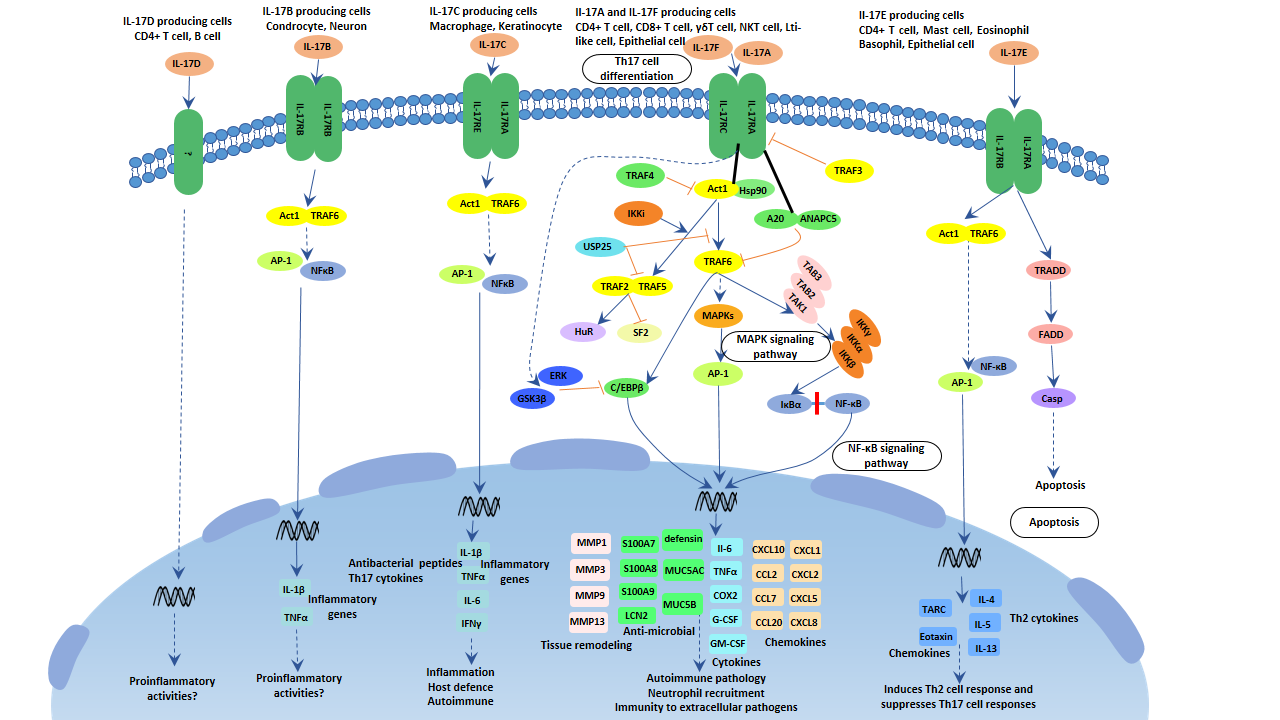
What Is IL-17?
The IL-17 family of cytokines contains six members, including IL-17/IL-17A, IL-17B, IL-17C, IL-17D, IL-17E/IL-25, and IL-17F, which are produced by many different cell types and primarily promote pro-inflammatory immune responses. Cytokines belonging to the IL-17 family are secreted as dimers and bind to members of the IL-17 receptor family.
There are 5 members in its receptor family, involving IL-17 R/IL-17RA, IL-17RB, IL-17RC, IL-17RD/SEF, and IL-17RE. All of these receptor subunits are type I transmembrane proteins that contain two fibronectin type III-like domains in their extracellular regions and a cytoplasmic SEF/IL-17 R/TIR (SEFIR) domain.
What Is the IL-17 Signaling Pathway?
In the IL-17 signaling pathway, IL-17 binds to its receptor, which activates extracellular signal-regulated protein kinase (ERK), c-jun N-terminal kinase (JNK), and p38/MAPK pathway, leading to the upregulation of IL-6, IL-1, and NF-kappa B.
The Function of IL-17 Signaling Pathway
The IL-17 signaling pathway is involved in host defense against extracellular bacterial & fungal infections and the onset of various autoimmune diseases.
The Mechanism of IL-17 Signaling Pathway
Unlike the other IL-17 family receptors, IL-17RA also contains a cytoplasmic Toll/IL-1 R-like loop (TILL), and a C/EBP beta activation domain (CBAD). The IL-17 family receptors oligomerize to form functional receptor complexes. Although the stoichiometry of these complexes is not well understood, the receptor for IL-17A, IL-17F, and IL-17A/F is thought to be a heterotrimeric complex consisting of two IL-17RA subunits and one IL-17RC subunit. The IL-17RA receptor subunit also interacts with IL-17RE and IL-17B R/IL-17RB to form functional receptor complexes for IL-17C and IL-17E/IL-25, respectively. IL-17 plays a critical role in host immunology. IL-17A is the hallmark in this family that it protects the host against extracellular pathogens, but also promotes inflammatory pathology in autoimmune disease, similar to IL-17C. While IL-17F involves in the mucosal host defense, IL-17E amplifies the Th2 immune response. The IL-17 family activates antibacterial cytokines and chemokines in MAPK, NF-κB and C/EBPs pathway.
TRAF6 is the earliest reported mediators in the 1L-17RA signaling pathway. Schwandner R et al. found that TRAF6 is necessary for the activation of NF -Kappa B and JNK by II-17A, and IL-17A cannot induce IL-6 production in mouse embryonic fibroblasts (MEFs) lacking TRAF6. However, there is no obvious TRAF6 binding site in IL-17RA, which indicates that there is another mediator between IL-17RA and TRAF6 as a bridge.
In 2003, Novatchkova M et al.discovered that the intracellular segment of the IL-17R family contained a conserved domain through bioinformatics analysis, and named it SEFIR. At the same time, an intracellular protein Act1 also contained the SEFIR domain was found. Act1 was originally named for its role as an intermediary molecule that activates NF-kappa B. However, recent studies have confirmed that Act1 is a bridge molecule between IL-17RA and TRAF6. Act1 is considered as the master mediator in this pathway. It can interact with IL-17R through the SEFIR domain. And Act1 contains the binding site of TRAF6. Act1 is required for IL-17R to activate NF-kappa B through Act 1 gene knockout or RNA interference. Further studies showed that Act1, as a U-box E3 ligase, utilizes the Ubc13 / Uev1A E2 complex to modify TRAF6 by K63 polyubiquitination at K124, mediating IL-17R downstream signaling and inflammatory gene expression.
IL-17 activates Erk through the SEFIR-TILL domain of IL-17RA, phosphorylating Thr188 of C / EBP beta. Phosphorylation of Thr188 is also necessary for the phosphorylation of Thr179 of C / EBP beta by GSK 3 beta. These two sequential phosphorylation events lead to the inactivation of C / EBP beta. Additionally, TRAF3 affects the formation of IL-17R-Act1-TRAF6 signal complex through competitive binding to IL-17R, effectively inhibiting IL-17 signal transduction and the induction of downstream inflammatory factors.





